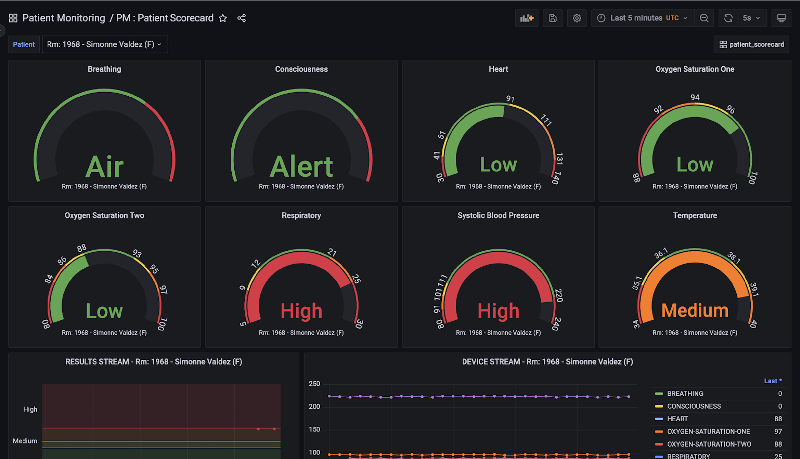Healthcare
Data-intensive software systems in the healthcare industry require demanding levels of performance, scalability, reliability, and security.
See Hazelcast in Action
Modernize applications with the Hazelcast Unified Real-Time Data Platform.
Introduction
In healthcare's data-driven operations, use of ill-suited technologies will be a huge disadvantage. Hence, industry IT decision-makers must explore diverse technologies to enhance efficiency.
A challenge lies in cost-effective integration of new capabilities. Real-time data processing and automation offer an advantage, particularly in addressing staff shortages.
With so many legacy systems in place today, justifying an overhaul can be tough, despite its long-term benefits. IT teams should target technologies that seamlessly integrate into existing systems, enabling advanced capabilities for novel opportunities.
Business Requirements
The healthcare sector consistently aims to offer affordable care to a wide population. Whether providers or payers, efficiency, speed, and security are crucial, alongside cost management. Additional requirements include:
- Improving provider productivity to maintain patient health, especially via medical technology that automates certain monitoring tasks in a real-time manner
- Secure health information sharing across organizations to help providers immediately understand patient health risks while staying in compliance with privacy regulations
- Cost-effective development and maintenance of online health portals that help patients keep in touch with provides and overall health status
- Minimizing the high costs associated with fraud, waste, and abuse with large-scale analytical systems
- Large-scale IT systems that can manage the huge volumes of patient data while staying within tight budget constraints
Technical Challenges
The healthcare industry faces many technical challenges that arise from the huge volumes of sensitive data they need to manage and process. Challenges include the following.
- Difficulty in building and maintaining real-time, 24/7 systems that continuously connect data silos (both within and across organizations) while adhering to the most stringent security requirements
- Cost-effectively analyzing huge volumes of data to detect and prevent fraud
- Complexity in building public-facing applications that deliver real-time information in a highly secure way
- Scaling IT systems cost-effectively to adapt to varying workloads
Why Hazelcast
Easy to Develop and Deploy
Hazelcast Platform was designed to simplify the application development process by providing a familiar API that abstracts away the complexity of running a distributed application across multiple nodes in a cluster. This allows developers to spend more time on business logic and not on writing custom integration and orchestration code. Our platform can seamlessly integrate with your IT architecture to add new capabilities without having to rip and replace your existing stack. The Hazelcast cloud-native architecture requires no special coding expertise to get the elasticity to scale up or down to meet highly fluctuating workload demands.
Performance at Scale
Whether you process a large volume of transactions, enhance online experiences with faster responsiveness, run large-scale transformations on data, or cut costs with a mainframe integration deployment, Hazelcast Platform is designed for the ultra-performance that today’s banking workloads require. The proven performance advantage is especially valuable for data-focused experimentation that enables ongoing business optimization, especially in data science initiatives including machine learning inference for fraud detection.
Mission-Critical Reliability
With built-in redundancy to protect against node failures, and efficient WAN Replication to support disaster recovery strategies that safeguard against total site failures, Hazelcast Platform was built to provide the resilience to run mission-critical systems. The extensive built-in security framework protects data from unauthorized viewers, and security APIs allow custom security controls for sensitive environments.
Customer Success Story
A prominent healthcare IT company seamlessly integrated Hazelcast Platform into its medical device connectivity system.
They designed a message bus with a strong focus on high availability, performance, and scalability for critical operations. This in-memory messaging system connects electronic health record (EHR) systems, mobile devices, and various medical equipment over the network. It manages notifications, escalated message routing, and sustains high availability even during WAN connection failures. Leveraging a microservices architecture, they achieve swift service failover for enhanced resilience. Their approach combines cloud and edge deployments for operational efficiency, particularly in areas with limited connectivity.
Hazelcast Platform stood out due to its superior performance and lightweight packaging, enabling deployment across various environments. It's effortlessly deployed centrally in the cloud or on devices near providers and patients, catering to limited computing resources. This consistency from edge to cloud streamlines development and maintenance. The company also utilizes Hazelcast for distributed caching, facilitating high-speed data reads and writes.
Use Cases
Hazelcast Platform is suitable for many types of data-intensive processes and operations in the healthcare industry. A sample of use cases is listed below.
- Prescription management, requiring fast and reliable message delivery
- Medical device messaging that alerts to changes in vital signs
- Real-time patient monitoring that alerts to non-obvious signs emerging health risks for in-patients
- Online provider/lab/patient portals for self-service access to health information
- Client engagement apps through web and mobile channels
- Fraud, waste, and abuse prevention, especially assisted by machine learning models
